Hello everyone, and welcome to explore the unsolved mysteries with me. Today we will discuss a bit about “The Mystery of Time”…
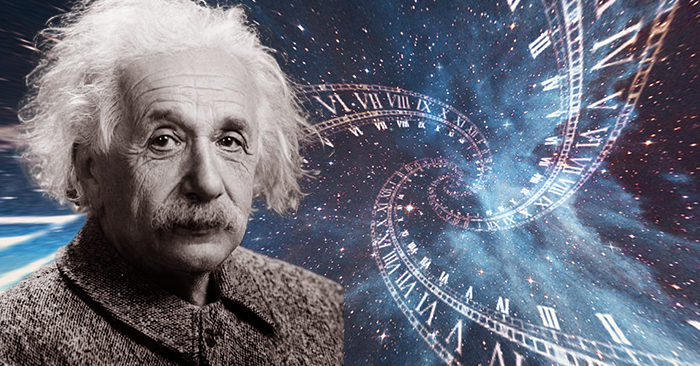
One of the most difficult mysteries in science: what is the truth of time? Is time just a misconception, everything is the brain’s self-deception glamor? (Illustrated collage)
In our busy daily lives, we often hear sentences like: “Hurry up, the deadline is over”, “Ah, I’m so busy, I don’t have enough time”. So, have you ever thought, what is the last “time”? Is time the transformation of the morning sun rising and the night setting? Or is it the operation of the seconds hand on the watch? People often think that time is a very simple and basic thing, slowly passing, flowing from the past to the future, which can be measured by a clock. But if someone told you that, the concept of time that we still perceive, it basically does not exist, time is just a human glamor, would you believe it?
Aristotle’s view of time
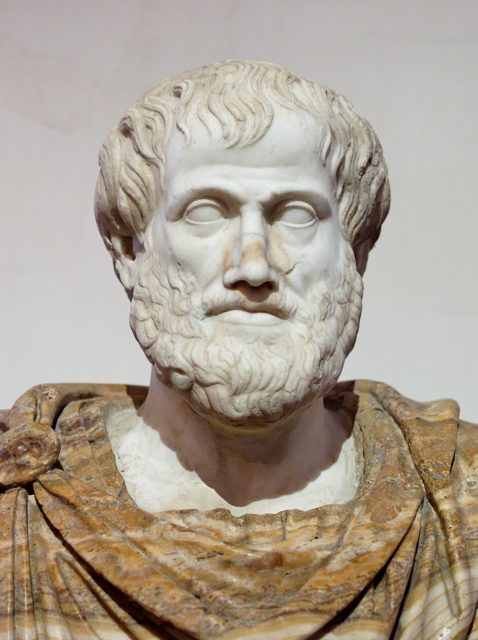
Roman marble replica of the portrait of Aristotle by Lysippos, c. 330 BC. (Source: Wiki)
It is known that the first person to ask the question “what is time” was Aristotle, a famous scientist and philosopher in ancient Greece. In his book “Physics”, he gave the earliest classical view of time in the history of Western thought. That view simply says, time is the measure of change.
For example, someone goes out in the morning and comes home after 2 hours. So these two hours are a measure of the time of the change born between “going out” and “going home”. At this point, everyone wants to ask, so according to Aristotle, if everything is not moving, no changes occur, will time stop? Does it no longer exist? If Aristotle could hear your question, he would answer: Yes, then time would not exist.
Then, people ask, so why when we turn off the lights at night and lie motionless in bed, ready to sleep, we can still feel the passage of time?
Aristotle also thought about this problem. He wrote in “Physics”: If the surrounding is covered with darkness, the body seems to be unable to feel anything, but in the mind some thoughts are going on, so of course we still feel. get the elapsed time. In other words, although everything looks static on the outside, the inner changes and changes in our thoughts are also a kind of movement. If things don’t move, there’s no time, because time is just a record of movement.
Newton’s Absolute Time
After hearing this, people must feel that Aristotle’s thinking is bizarre? If you think so, it’s because people have absorbed the Newtonian view of time taught to us by modern physics in schools. What is it?
Newton is one of the founders of modern natural science and is hailed as the “father of modern science”. He believes that in the world, no matter what, there is a “true” time, which is independent of the changes of things. Even if all objects maintain a state of motionlessness, even if the activity of our souls is stopped, this kind of time will still pass by without any effect.
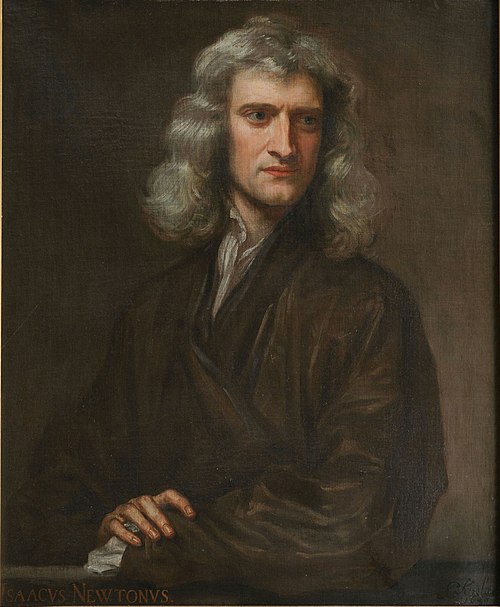
Portrait of Newton at 46 years old by Godfrey Kneller, 1689. (Source: Wiki)
In Newton’s method of physics equations, the letter t represents time. He assumed time t to be an entity independent of things, existing realistically and passing as linear motion. In recent centuries, modern physics has developed on the basis of applying Newton’s model; Scientists have used different types of physical formulas to describe the world, and all of these formulas contain t – the quantity of time as defined by Newton.
Although many people consider the view that “time is independent and equal” to be common sense, for humanity, however, it is not an ancient natural intuition. In fact, most philosophers do not completely agree with Newton’s views.
The famous German mathematician and philosopher Leibniz strongly opposed Newton’s view of time. It is said that Leibniz’s name was originally written as Leibnitz, with a t in the middle. But to show that he did not believe in Newton’s absolute time t, he removed the letter t from his own name, so his name later became Leibniz.
Einstein: Time is a glamor
Just when people were caught between two giants of two eras – Aristotle and Newton – to see whose point of view was the truth, Einstein, a giant scientist who created a new era, came out with “Theory” relative”. He told people that “time is but an glamor” and that “man’s distinction between past, present and future is ultimately a misunderstanding, a persistent misunderstanding”.
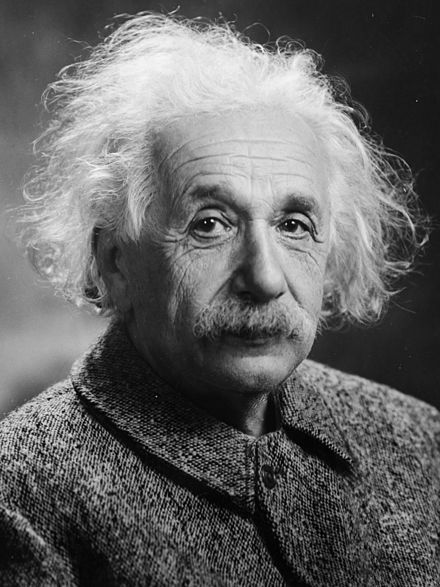
Albert Einstein (1947)
How do you explain this? Before we talk about this, let’s talk about an unexpected puzzle that has baffled many physicists – the constant speed of light, the constant optical speed for short.
What does it mean? We usually know that speed is relative. For example, if a person is sitting on a train at 50 meters per second, a ball on the train is rolling at 3 meters per second. In the eyes of the person sitting on the train, the speed of the ball is 3 meters per second, but in the eyes of the people on the platform, the speed of the ball needs to overlap the speed of the train, which is 53 meters. /second.
Many people assume that the speed of light is of course the same. However, in 1887, an experiment conducted by two American physicists Michelson and Morley brought unexpected results to everyone. This experiment became known to later generations as the “Michelson-Morley Experiment”. In experiments, they found that, regardless of whether the earth’s motion is in the same direction or opposite to the direction of light emission, the measured speed of light is the same, which means that the optical speed does not change.
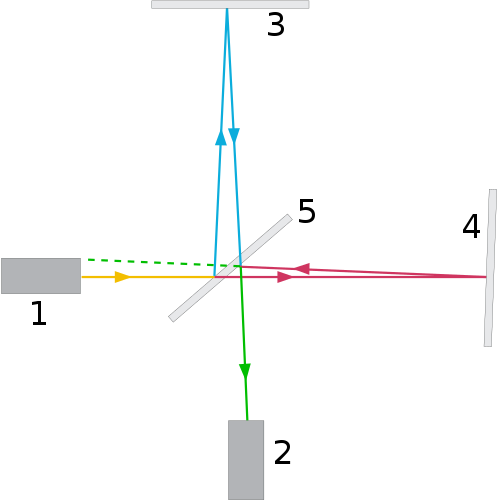
Michelson-Morley experiment diagram, (1) = Co-phase light source, (2) = Receiver, (3) = Mirror 1, (4) = Mirror 2, (5) = Semi-plated mirror.
If we follow this conclusion, it means that, if the ball in the train example were replaced by a “photon”, then either the person on the train or the person on the platform would see the “photon” moving at speed 3 meters/second.
The “Michelson-Morley experiment” has been carried out for decades, the experimental environment and conditions have changed many times, but the conclusions remain the same. How can this be?
Time “magic transformation”
Now, it’s finally Einstein’s turn to solve the mystery for everyone. Einstein believed that there is neither absolute time nor absolute space. He proposed a theory of the “unity of time – space”, that is, time and space are one, called space-time. That is, we can’t just say time like this, or space like this separately, but should say spacetime like this. Physicists call the emission of matter constituting the real world a “field”, such as a temperature field, an electromagnetic field, and spacetime is the gravitational field.
Gravitational fields and other matter in the world are no different, they are all fields. The world is a superposition of many fields, and the gravitational field is just one layer of them. Like other fields, it is neither absolute, nor uniform, nor fixed – it can bend, stretch, and interact with other fields.
The gravitational field, which is also the space-time field, at times resembles a plane – this is the version described by Newton; but it can also oscillate – what we call a gravitational wave is just that, it contracts and expands.
In this way, one solved the question of the phenomenon of “invariant optical speed”, which is caused by the variation of time. So, is there any rule in this variation of time?
Speaking of this, it is impossible not to mention Einstein’s theory of relativity. Einstein’s theory of relativity includes two theories: “special relativity” and “general relativity”. According to special relativity, time for a high-speed moving body passes more slowly than for a stationary object. And general relativity says that the time of an object in a stronger gravitational field passes more slowly than the time of an object in a weaker gravitational field – the same person standing on the ground, the time at the beginning of the he moves faster than time at his feet, because his head is farther from the ground than his feet, so the gravitational field weakens a bit. Based on this view, there is a scientific basis to believe that standing upside down will make people younger!
So, was Einstein right? Let’s take a look at a few classic and interesting examples.
Experiment with atomic clocks
In 1971, two scientists, Joseph Hafele and Richard Keating, conducted an experiment with several cesium atomic clocks.
Everyone knows that this atomic clock is extremely accurate. For an atomic clock in Germany, the time error in 187 million years is less than a second. Therefore, it is very reliable to use in an experiment to measure whether time changes or not.

The watch used in the Hafele-Kieting experiment.
Returning to the experiment, Hafele and Keating placed two atomic clocks on two commercial airliners simultaneously flying east and west, and compared them with the atomic clocks mounted on the United States Navy Observatory. Ky.
The reason why one plane flies east and the other goes west – is so that the plane flying forward with the earth’s rotation has a relatively faster speed, while the plane flying against The rotation of the earth is naturally relatively slower, and the speed difference between these two planes will become large, the difference in experimental results will be more obvious.
As we said above, according to general relativity, where the gravitational field is weaker, time becomes faster, and according to special relativity, the time of a faster object becomes Slower. The atomic clock on the plane is at “high speed and altitude”, while the atomic clock of the US Navy Observatory is “at rest on the ground”, hence the two elements of relativity in Einstein’s theory. It will be considered.
What are the results of the experiment? The atomic clock on the plane flying east was 59 nanoseconds slower than the clock on the ground, and the atomic clock on the plane flying west was 273 nanoseconds faster than the clock on the ground. Einstein’s theory of general relativity and special relativity were tested simultaneously.
In fact, the GPS navigation system we are using today requires a daily clock calibration according to the theory of relativity. Otherwise, the atomic clock on the satellite would be 38 microseconds faster than on the ground every day. Don’t think too little, because if we assume that the GPS system requires nanosecond time accuracy, the error is very significant: 38 microseconds is equivalent to 38,000 nanoseconds, if not corrected. , the GPS system will accumulate a positioning error of about 10 km per day.
NASA’s Twin Experiments
In 2015, NASA conducted a special life interaction experiment, they found a pair of twin astronauts, Scott Kelly and his brother Mark Kelly, because they are identical twins, so they have the same genome. similar.
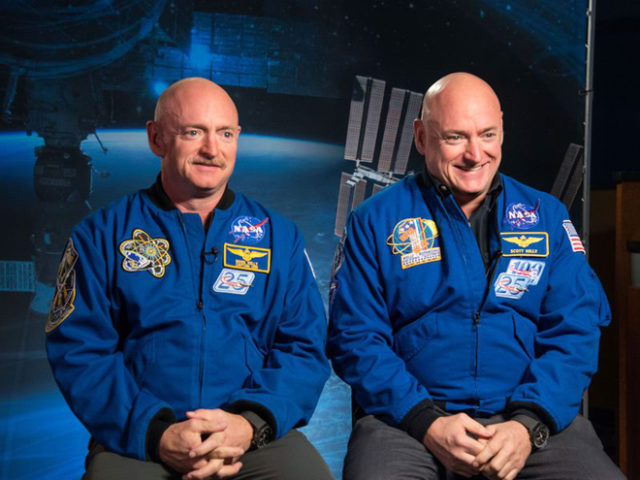
NASA sent Scott into space and stayed on the International Space Station for 340 days, while his brother stayed on Earth. After Scott returned, they compared the genetic changes between the two to study the impact of life in space on the human body.
Everyone take a look at the photos released by NASA. Do you think Scott, who went into space and lived in a high-speed flight around the earth, looks younger? However, since NASA hasn’t released photos of the two before taking part in the experiment, we’re also not sure if Scott looks younger than he originally was. But NASA research has proven that Scott ages more slowly than Mark. What’s happening?
It turns out that when NASA conducted genetic testing, it was discovered that during Scott’s space flight, his body’s aging process slowed down significantly because of the “telomeres” located at the ends of the infection. Chromosomes shorten at a slower rate.
What is this telomere? Telomere is a small piece of DNA that exists at the end of cell chromosomes, its function is to avoid chromosomal damage, but as people age, telomeres will shorten, cells gradually age and die. In this twin space experiment, Scott’s telomeres shorten at a slower rate, while Mark’s telomeres continue to age at a normal rate.
But when Kelly returned to Earth, his telomeres quickly returned to their normal shortening rate.
The ancients said: “One day in heaven, one thousand years on earth”; or: “One day in the sky, a few years down here” – it seems impossible to underestimate the wisdom of our ancestors.
Cosmic block
Based on Einstein’s theory of relativity, in 2015, MIT philosophy professor Bradford Skow proposed the “massive universe” theory.
This theory states that, according to Einstein’s theory of “time-zero unity”, since time and space are inseparable, they are both 1-dimensional time and 3-dimensional space, this is a set of part of the four-dimensional universe. Then, everything that arises in it has its own coordinates in time-zero.
The mass of the universe is absolutely static, in the static four-dimensional space-time, there is no passage of time, nor the movement of the stars, the world is a static mass, on the time axis, each time point relative to each other. corresponds to a scene of a three-dimensional space at that moment, and the whole universe is composed of a multitude of such three-dimensional scenes.
If we could jump out and look at the universe, it would be like watching a movie in our world, you could choose any time to see what happened at that moment. .
When it comes to watching movies, everyone knows that after pressing the play button, the movie will continuously play over time. Putting it in the theory of the universe, perhaps there is also something like pressing the “play” button, which makes us humans feel the passage of time cannot be reversed.
MIT physicist and philosopher Max Tegmark and British physicist Julian Barbour believe that this switch is our brain, and the passage of time is the brain’s glamor we. The neural structure of the brain allows us to have memories of the past, but we don’t know what will happen in the future. That’s why memory gives people the notion that time is passing, making us think that everything is from the past to the present, and then to the future.
If the universe really is like that, how can we get out of the glamor and see the past, present, and future? The current level of science is not possible. So can anyone do it?
The Story of Buddha Shakyamuni
In ancient India, after usurping the throne, King Luu Ly, the second son of King Pasena, decided to attack the Kapilavad Kingdom and destroy the kin of Shakyamuni Buddha.
Shakyamuni Buddha three times in a row with the army set out to dissuade King Luu Ly. For the third time, the flying dragon and the golden phoenix appeared to block the enemy’s path. King Luu Ly was moved and scared, and withdrew his army to return to the country. However, unable to withstand the instigation of his courtiers, King Luu Ly sent troops to the fourth time, and this time Buddha Shakyamuni did not stop him. In the end, the entire Shakyamuni clan was annihilated.
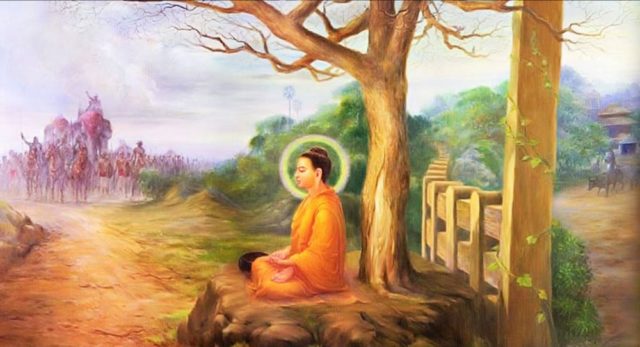
The Buddha sat under a tree with sparse branches, preventing King Luu Ly from going to fight the Shakyamuni family.
Muc Kieu Lien, a disciple of Shakyamuni Buddha asked the Buddha why. The Buddha told that in the past, King Luu Ly was once a fish king (king of fish), ruling over fish, turtles, shrimp, and crabs in the river. People living along the river like to eat fish, after eating all the fish, they caught a very large fish king, at that time there were a total of five hundred people who ate the fish king’s meat. The clan of Shakyamuni was the fish eaters at that time. At that time, Buddha Shakyamuni was young, he didn’t eat fish, but out of curiosity, he hit the fish king three times. After he became a Buddha, he had a headache for three days. This is also the reason why the fish king reincarnated as King Luu Ly to destroy the Shakyamuni clan.
Regarding the fate of King Luu Ly, Buddha Shakyamuni predicted that, after the slaughter of the Sakyan clan, King Lulu and his army would be annihilated in seven days. Seven days later, a sudden storm fell from the sky, the capital was flooded, and King Luu Ly and his country completely perished.
Buddhism believes that an enlightened practitioner can see through all causes and conditions, and can observe the past, present, and future. In this way, Buddha turned out to be the greatest ‘scientist’ ever.
